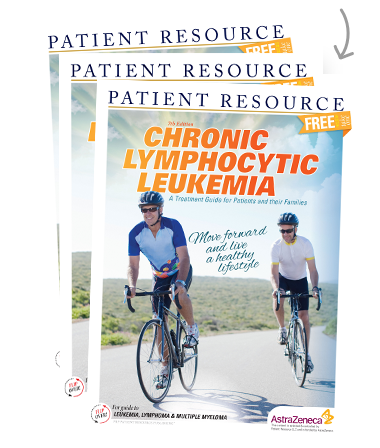Chronic Lymphocytic Leukemia
Supportive Care
Most people are concerned about the side effects of cancer and its treatment (see Table 1). Knowing the symptoms to watch for and the actions to take when they occur will help you feel more in control. Tell your health care team when symptoms occur. Download a free side effects tracker at PatientResource.com/Tracker.
Potentially Severe Side Effects
Some drug therapies may be accompanied by serious and potentially life-threatening side effects. Talk with your doctor about how to identify the symptoms, those that require emergency care, and whom to contact and how, especially after hours. Prompt treatment is necessary to keep these symptoms from becoming fatal. Some can be identified only with lab work and imaging tests, so keep your follow-up appointments.
Following are some potentially severe side effects to watch for.
Cardiac-related Adverse Effects. These may include conditions such as atrial fibrillation (AFIB), hypertension, irregular heartbeat, dizziness or shortness of breath.
Infections. Report any of the following symptoms immediately: fever (oral temperature higher than 100.4°F), chills and sweating; flu-like symptoms (body aches, general fatigue) with or without fever; cough, shortness of breath or painful breathing; sore throat; mouth sores; redness, pain or swelling on any area of your skin; pus or drainage from any open cut or sore; diarrhea; pain or burning with urination; or vaginal drainage or itching.
Cytokine Release Syndrome (CRS). This occurs when too many cytokines are released into the bloodstream, leading to high fever, inflammation, fatigue and nausea that can be severe and damage multiple organs. Without swift medical treatment, CRS can be fatal.
Hepatic Toxicity (liver damage). Symptoms may include rash, fever, stomach pain, nausea and vomiting, jaundice (yellow color in the eyes and skin) and fatigue.
Immune-related Adverse Events (irAEs). Immunotherapy drugs may cause the immune system to attack normal, healthy parts of the body. Talk with your doctor about the symptoms so you and your caregivers can report problems immediately.
Infusion-related Reactions (IRRs). This response may occur with an intravenous (IV) or injectable treatment. Mild reactions may include itching, rash or fever. Potentially life-threatening symptoms include shaking, chills, low blood pressure, dizziness, breathing difficulties or irregular heartbeat.
Tumor Lysis Syndrome (TLS). As tumor cells die, they break apart and release their contents into the blood, causing a change in electrolytes and certain chemicals in the blood. It may damage the nervous system, kidneys, heart, liver and other organs.
Emotional Well-being
At times you may feel scared, angry or depressed, while at other times you may feel hopeful. Simply knowing you may be on an emotional rollercoaster helps because now you can make a plan.
Start with your family and friends. When they offer help, accept it. Seek medical attention immediately if you feel depressed or hopeless for more than a few days or have thoughts of suicide.
Table 1. Some Common Physical Side Effects
| Side Effect* | Symptoms |
| Anemia | Low energy, weakness, dizziness, light-headedness, shortness of breath, rapid heartbeat |
| Bone loss and pain | Weakened bone caused by the cancer or treatment |
| Chemo brain (cognitive dysfunction) | Brain fog, confusion and/or memory problems |
| Constipation | Difficulty passing stools or having less frequent bowel movements compared to your usual bowel habits |
| Diarrhea | Frequent loose or watery bowel movements that can become serious if left untreated |
| Fatigue | Tiredness that is much stronger and harder to relieve than the fatigue an otherwise healthy person has |
| Fever | Raised body temperature that could signal an infection |
| Nausea and vomiting | The feeling of needing to throw up and/or throwing up |
| Neutropenia | Low white blood cell count that increases the risk of infection |
| Peripheral neuropathy | Numbness, pain, burning sensations and tingling, usually in the hands or feet at first |
| Respiratory problems | Shortness of breath with or without coughing, upper respiratory infections |
| Skin reactions | Rash, redness and irritation, or dry, flaky or peeling skin that may itch |
| Thrombocytopenia | Low number of platelets in the blood, which can lead to bruising and bleeding |
Meet Your Team
Dermatologists diagnose and treat skin problems. Because of the related skin cancer risk, you are encouraged to see a dermatologist regularly.
Hematologists specialize in treating people who have blood cancers.
Medical oncologists diagnose and treat cancer with drug therapy.
Oncology nurses provide patient care in a cancer treatment facility.
Pathologists have special training in identifying diseases by studying cells and tissues under a microscope.
Patient navigators and nurse navigators serve as guides through diagnosis, treatment and follow-up.
Pharmacists have special training in preparing, dispensing and explaining the side effects of prescription drugs.
Psychologists/onco-psychologists address psychological, emotional and social issues that affect people with cancer and their loved ones.
Radiation oncologists treat cancer using radiation therapy.
Registered dietitians and nutritionists help meet patients’ nutritional needs.



